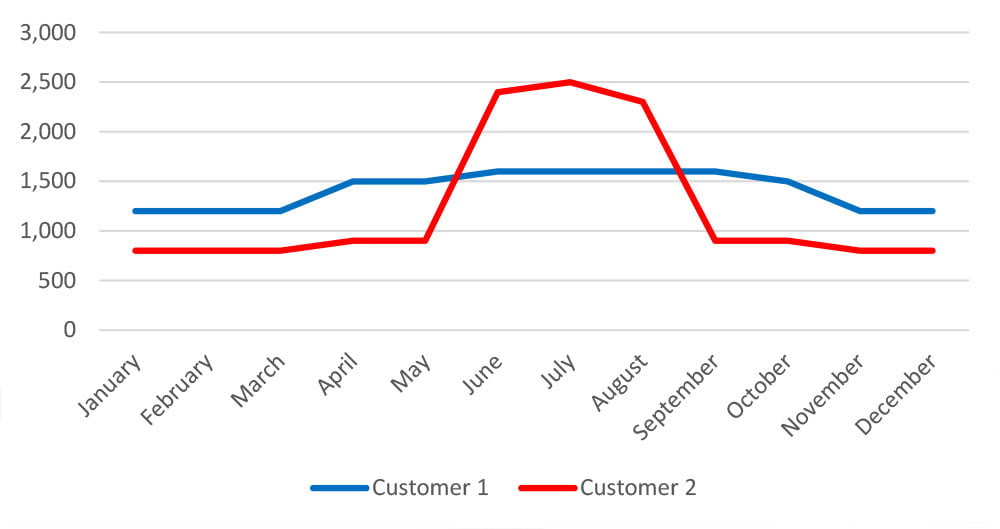There are many different components on your electricity bill that make up the overall expense. One component that is often included in your total supply price is a capacity charge. For many, capacity charges make up the second largest cost-per-kwh of your total electricity supply price.
Capacity charges are the rates customers pay to ensure a sufficient supply of energy is available on a power grid during “peak” hours of electricity usage. Essentially, you are paying a fee to ensure that the electricity you might eventually use is there for you when you need to use it. And just like the price of electricity differs depending on location, capacity price also differs by location. Therefore, capacity charges may differ from customer to customer.
Why Do We Need Capacity Charges?
So why are you being charged for electricity that you may or may not need? It’s a good question and the answer is simple. Capacity payments to electricity generators help incentivize the companies to produce the maximum amount of electricity they are capable of at a moment’s notice. The capacity costs paid by consumers are given to the generators to produce electricity when needed. If generators fail to produce, there may not be enough electricity, which could lead to an emergency situation and the generator could face very large fines. In exchange for capacity payments, the generator’s job is to ensure that electricity always remains available to all consumers. That means you’ll always have the energy you need, when you need it.
Electricity Providers and Capacity Charges
Electricity generators receive payments to guarantee production of electricity when needed. Since the consumers are the ones using the electricity, the charges trickle down from the generators to the electricity providers, who then pass the charges on to their consumers.
How Are Capacity Charges Calculated?
Capacity charges are based on a consumer’s Peak Load Contribution (PLC) throughout the year. While all participating states use PLC, the way it is calculated differs between them. Some states, like New York, base the capacity on a peak hour timeframe from the previous year. Other states within the PJM zone determine the PLC over the top five (5) peak electricity hours based on the average amount. The total capacity charges are then converted to a cost per KW for each consumer based on their PLC and charged to the consumer.
Reducing Your Capacity Charges
The good news is there are ways to reduce your capacity charges. One of the most effective ways to bring costs down includes participating in your local Demand Response (DR) or Peak Load Contribution (PLC) Programs. These programs are typically run through the electricity provider.
DR or PLC programs require a consumer to limit their electricity consumption during specific periods of time when forecasts indicate that there may be strain on the grid. Some states calculate the capacity charge based on estimated peak demand times that happen throughout the year. While each state or location has their own rules, consumers can benefit by knowing which upcoming dates are defined as peak demand and can lower their rates by consuming less electricity during those defined periods of time. Consumers can even subscribe to alerts that notify them to reduce consumption during specific peak demand timeframes. The consumer, however, will not see a decrease in charges during the current year on their bill. The impact in decreasing consumption will appear the following year once each consumer’s PLC is recalculated.
Visualize It
The graph below shows two (2) example customers – Blue Customer and Red Customer.

The capacity obligation is much higher for the Red Customer because they used more electricity during the peak time of the year, which is typically in July or August when consumers are using more electricity. Therefore, they are responsible for 5.33 KW of generation being available for every hour of the entire year, multiplied by the capacity price during the different time periods. Because the Red Customer uses significantly more electricity during the peak time of year, it is very costly for them during the non-summer months despite their kWh consumption returning to lower levels.

The Blue Customer, however, participated in a PLC program, which reduced or shifted their energy consumption during peak demand
times. As you can see, their consumption was balanced throughout the year, making the blue customer responsible for 3.56 KW of generation per hour for the entire year. That is a cost savings of $0.007 per hour.
Capacity charges are one of the most important costs for businesses to manage. By determining which days are most likely to witness peak usage levels, you can lighten your usage on those days and potentially reduce your capacity costs – leaving more money to allocate toward other expenses.


